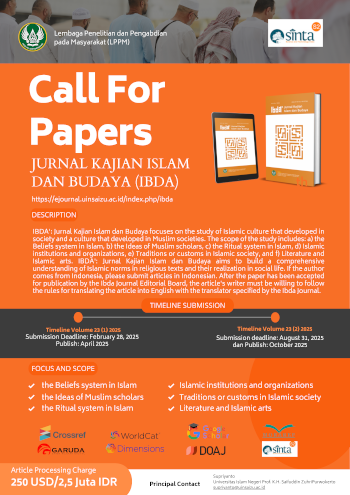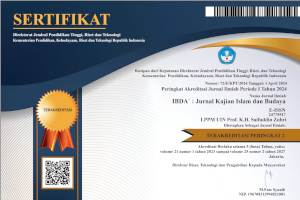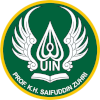Musical Expression of Islamic Identity: The Syncretism of Blangikhan Ritual in Lampung
DOI:
https://doi.org/10.24090/ibda.v22i2.9708Keywords:
blangikhan ritual, musical, Islam, islamic identity, musical expressionAbstract
The Blangikhan ritual underscores the significance of dignity within Lampung's culture, where the community is renowned for its hospitality and compassion towards one another. Blangikhan is a celebration and reflects community values, norms, and beliefs. This study aims to comprehend and explore the intertwined musical practices in the Blangikhan tradition of the Lampung community's religious and cultural identity. The researcher explores the correlation between the music produced in the Blangikhan tradition and the strengthening of Islamic identity among the community. The research utilized an ethnographic method. The data collection techniques were observation, interview, literature study, and documentation. The result concludes that music is an integral component of this event and reflects the Islamic Identity within Lampung's culture. The music in this ritual encompasses various genres, including Hadrah music, a religious musical tradition with sholawat lyrics, the music accompanying the Bedana dance that blends Malay-Islamic nuances, and even pop music with religious themes. This research delves deeper into how music in the Blangikhan ritual mirrors the Islamic identity and how the Lampung community incorporates Islamic elements into their performing arts. The study also considers how the production of this music influences the representation of Islamic identity within the Blangikhan ritual. This research holds significant relevance in comprehending how culture and religion can interact and shape identity within a cultural ritual context.Downloads
References
Aprilia, E. (2019). Bentuk Koreografi Tari Bedana Hasil Revitalisasi Taman Budaya Provinsi Lampung. Joged, 9(1). https://doi.org/10.24821/joged.v9i1.2496
Aswir, & Misbah, H. (2018). Dakwah Islam Melalui Seni Hadrah Di Desa Hargomulyo Kecamatan Sekampung Kabupaten Lampung Timur. In Photosynthetica (Vol. 2, Issue 1).
Badan Pusat Statistik Lampung. (2022). Statistik Sosial dan Budaya Masyarakat Lampung. Lampung: BPS Lampung.
Fikri, S. (2014). Seni musik dalam perspektif islam. Studi Multidisipliner, 1(2).
Hall, S. (1997). Introduction & The Work of Representation. Representation: Cultural Representations and Signifying Practices.
Hasan, M. (2022). Musik dan Identitas: Peran Tradisi Blangikhan dalam Masyarakat Lampung. Jurnal Musik dan Budaya, 15(2), 45-60.
Indrawan, A. (2012). MUSIK Di Dunia Islam Sebuah Penelusuran Historikal Musikologis. TSAQAFA, Jurnal Kajian Seni Budaya Islam, 1(1).
Iswanto, A. (2015). The Function of Art Tambourine to the Society in Lampung Fungsi Seni Hadrah pada Masyarakat Lampung. Jurnal Bimas Islam, 08(2).
Jamil, S. (2022). Musik dalam Pandangan Islam. Musikolastika: Jurnal Pertunjukan Dan Pendidikan Musik, 4(1). https://doi.org/10.24036/musikolastika.v4i1.82
Jhally, S. (1997). Stuart Hall: Representation & The Media. Media Education Foundation.
Mohd Mokhtar, R. A., & Sa‘ari, C. Z. (2016). Sinkretisme dalam Adat Tradisi Masyarakat Islam. Journal of Usuluddin, 43(1). https://doi.org/10.22452/usuluddin.vol43no1.3
Mohd Mokhtar, R. A., & Sa’ari, C. Z. (2015). Konsep Sinkretisme Menurut Perspektif Islam. Jurnal Akidah & Pemikiran Islam, 17(1). https://doi.org/10.22452/afkar.vol17no1.3
Moshinsky, M. (1959). Komodifikasi Kesenian Islam, Tari Bedana Tradisional di Bandar Lampung. Nucl. Phys., 13(1).
Rahman, A. (2020). Peran Musik dalam Tradisi Blangikhan: Studi Kasus di Lampung. Jurnal Penelitian Sosial dan Budaya, 12(1), 23-37.
Sari, R. (2021). Tradisi Blangikhan di Lampung: Antara Musik dan Identitas Islam. Jurnal Ilmu Agama dan Budaya, 10(3), 78-89.
Sasongko, A. (2018). Musik dalam Peradaban Islam. Republika.
Wakhid, I. R. dan A. A. (2019). Tradisi Islam Pesisir: Ritual Ngumbai Lawok Di Kabupaten Pesisir Barat Provinsi Lampung. Al-Adyan: Jurnal Studi Lintas Agama, 14, NO. 2.
Downloads
Published
How to Cite
Issue
Section
License
Copyright (c) 2024 Citra Aryandari, Delsi Chaniago

This work is licensed under a Creative Commons Attribution-ShareAlike 4.0 International License.
Authors who publish with this journal agree to the following terms:
- Authors retain copyright and grant the journal right of first publication with the work simultaneously licensed under a Creative Commons Attribution-ShareAlike License a that allows others to share the work with an acknowledgement of the work's authorship and initial publication in this journal.
- Authors are able to enter into separate, additional contractual arrangements for the non-exclusive distribution of the journal's published version of the work (e.g., post it to an institutional repository or publish it in a book), with an acknowledgment of its initial publication in this journal.
- Authors are permitted and encouraged to post their work online (e.g., in institutional repositories or on their website) before and during the submission process, as it can lead to productive exchanges, as well as earlier and greater citation of published work (See The Effect of Open Access).
















